Condiciones específicas de la prueba de alta y baja temperatura de la batería de un VE (vehículo eléctrico)
There are mainly 2 types of vehicles:
1. Battery for pure electric vehicle
2. Fuel cell, dedicated to fuel cell electric vehicles
Thermal test: This test is performed to characterize the reaction of cells to the high-temperature environment.
a) Adjust the SOC of battery to 100% of BEV application and 80% of HEV application.
b) Batteries stabilized at room temperature shall be placed in a gravity or circulating air convection oven. The oven temperature shall be raised to 130 ℃ ± 2K at the speed of 5K/min. The battery shall be held at this temperature for 30 minutes before stopping the test.
Temperature Cycle Test:
This test is conducted to characterize the thermal durability of the battery by alternately exposing it to low and high temperatures to cause expansion and contraction of the battery components.
a) Adjust the SOC of battery to 100% of BEV application and 80% of HEV application.
b) Conduct temperature cycling according to ISO 16750-4. As shown in Table 4, the ultra-low operating temperature shall be – 40 ℃ or Tmin specified by the battery manufacturer, and the maximum operating temperature shall be 85 ℃ or Tmax specified by the battery manufacturer. Perform 30 test cycles as specified.
The battery shall be heated in a gravity convection or circulating air oven with an initial temperature of 20 ± 5 ° C (68 ± 9 ° F). The temperature of the oven is raised to 130 ± 2 ℃ (266 ± 3.6 ℉) at the rate of 5 ± 2 ℃ (9 ± 3.6 ℉) per minute and maintained for 10 minutes. The sample shall be returned to room temperature (20 ± 5 ℃) and then checked. For batteries with a set temperature higher than 100 ℃ (212 ℉), the regulating temperature shall be increased from 130 ± 2 ℃ (266 ± 3.6 ℉) to 30 ± 2 ℃ (86 ± 3.6 ℉) from the manufacturer’s maximum specified temperature. For lithium metal chemical battery, the regulating temperature shall be increased to 170 ± 2 ℃ (338 ± 3.6 ℉) at most.
The above contents are excerpts from the network. Please contact us if you have any questions.
Recomendaciones relacionadas
-
Summary – the cause of the failure of the 85 ° C ultra-low temperature refrigerator
924-85 ° C ultra-low temperature refrigerator in industrial cold treatment, with the development of industry, the scope of use is also wider. However, in the process of use, it will inevitably lead to failure, so how much do you know about common fau...
Ver detalles -
Maintenance and maintenance of battery pack test temperature simulation chiller
881The battery pack test temperature simulation chiller is more and more widely used in enterprises, but the subsequent maintenance and maintenance are also more important. Here is a brief introduction to some maintenance and maintenance methods. 1....
Ver detalles -
Basic Structure of Industrial Water Chiller
1020Basic structure of industrial water chiller:Industrial water chiller consists ofcompressor, condenser, evaporator, expansion valve and other accessories.1. Compressor: in the industrial water chillersystem, the compressor is the power to ensu...
Ver detalles -
Why do machine tool spindles require chillers?
869The main reasons why machine tool spindles require a chiller are as follows: Temperature Control: During the machining process, the spindle generates a large amount of heat due to high-speed rotation. If not controlled, this heat ...
Ver detalles
 LNEYA Enfriadoras industriales Fabricante Proveedor
LNEYA Enfriadoras industriales Fabricante Proveedor













